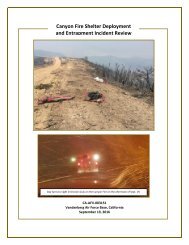Final Report to the Joint Fire Science Program
13-1-04-45_final_report
13-1-04-45_final_report
Create successful ePaper yourself
Turn your PDF publications into a flip-book with our unique Google optimized e-Paper software.
Coop & Magee P-J Fuel Treatment Effects 12/31/2016<br />
Abstract<br />
Mastication and hand-thinning treatments are increasingly utilized by land managers as a means<br />
of reducing tree cover for fire hazard mitigation and o<strong>the</strong>r habitat objectives in piñon-juniper (P-<br />
J) woodlands. However, <strong>the</strong> effects of <strong>the</strong>se treatments on ecological processes including fire,<br />
and on a wide range of species, particularly vulnerable P-J obligate birds, are incompletely<br />
unders<strong>to</strong>od. To address <strong>the</strong>se knowledge gaps we measured vegetation and fuels, and conducted<br />
bird point counts at 232 sites in 29 pairs of 1-11-year-old treatments and untreated adjacent<br />
controls in P-J woodlands of <strong>the</strong> Arkansas River valley in central Colorado. We used a suite of<br />
statistical approaches including paired t-tests, mixed-effects models, and occupancy analysis, <strong>to</strong><br />
assess treatment impacts on vegetation, fuels, and bird occupancy. We also developed fire<br />
behavior models <strong>to</strong> examine expected treatment impacts on fire behavior along gradients of fuel<br />
loads and under varying fuel moisture scenarios.<br />
Treatments drove major, persistent ecological shifts relative <strong>to</strong> controls. Tree cover and canopy<br />
fuels were reduced; concomitantly, down woody surface fuels, forb, and grass cover increased.<br />
Treatments exhibited rapid, large, and persistent increases in <strong>the</strong> frequency, richness, and cover<br />
of 20 non-native plant species including cheatgrass (Bromus tec<strong>to</strong>rum). Exotic plant expansion<br />
appears linked <strong>to</strong> <strong>the</strong> disturbance associated with treatment activities, reductions in tree canopy,<br />
and alterations <strong>to</strong> ground cover. Effective mitigation of non-native plant species may necessitate<br />
additional pre- and post-treatment control measures. Treatments substantially reduced <strong>the</strong><br />
occupancy of piñon-juniper specialist and conifer obligate bird species including <strong>the</strong> Virginia’s<br />
Warbler and Gray Flycatcher at <strong>the</strong> landscape scale and <strong>the</strong> Piñon Jay at <strong>the</strong> local scale. Bird<br />
species that used open and edge habitats such as <strong>the</strong> Mountain Bluebird and <strong>the</strong> Lark Sparrow<br />
increased in occupancy within treatments.<br />
Decreased canopy fuels and increased herbaceous surface fuels including exotic annuals are<br />
expected <strong>to</strong> alter potential fire behavior via reduced active crown fire probability, but also<br />
increased surface fire intensity, flame length, and rate of spread. Modeled fire behavior suggests<br />
that under most conditions, treatments will be highly effective at reducing active crown fire risk,<br />
but also that treatments generally removed more trees than necessary <strong>to</strong> mitigate this risk.<br />
Retention of more trees within treatments will benefit P-J obligate birds. <strong>Fire</strong> behavior models<br />
also indicated that residual trees were still highly susceptible <strong>to</strong> passive crown fire (<strong>to</strong>rching),<br />
particularly in masticated sites. Models including simulated treatment modifications suggest that<br />
this remaining crown fire risk could mostly be eliminated via follow-up surface fuel reductions<br />
(e.g., Rx fire) and/or crown base height increases (e.g., pruning). As such, we propose that<br />
managers consider additional post-treatment fuels interventions <strong>to</strong> increase <strong>the</strong> fire resistance of<br />
residual trees, which is anticipated <strong>to</strong> yield both social and ecological benefit. We encourage<br />
managers carrying out P-J mastication projects <strong>to</strong> explicitly consider 1) potential trade-offs<br />
between desired treatment outcomes and potentially unwelcome impacts, and how <strong>the</strong>se might<br />
be mitigated, and also 2) whe<strong>the</strong>r or not tree removal treatments may be warranted given<br />
anticipated climate change impacts <strong>to</strong> <strong>the</strong>se woodlands.<br />
2




